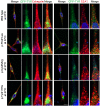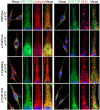Molecular genetic studies and delineation of the oculocutaneous albinism phenotype in the Pakistani population
- PMID: 22734612
- PMCID: PMC3537634
- DOI: 10.1186/1750-1172-7-44
Molecular genetic studies and delineation of the oculocutaneous albinism phenotype in the Pakistani population
Abstract
Background: Oculocutaneous albinism (OCA) is caused by a group of genetically heterogeneous inherited defects that result in the loss of pigmentation in the eyes, skin and hair. Mutations in the TYR, OCA2, TYRP1 and SLC45A2 genes have been shown to cause isolated OCA. No comprehensive analysis has been conducted to study the spectrum of OCA alleles prevailing in Pakistani albino populations.
Methods: We enrolled 40 large Pakistani families and screened them for OCA genes and a candidate gene, SLC24A5. Protein function effects were evaluated using in silico prediction algorithms and ex vivo studies in human melanocytes. The effects of splice-site mutations were determined using an exon-trapping assay.
Results: Screening of the TYR gene revealed four known (p.Arg299His, p.Pro406Leu, p.Gly419Arg, p.Arg278*) and three novel mutations (p.Pro21Leu, p.Cys35Arg, p.Tyr411His) in ten families. Ex vivo studies revealed the retention of an EGFP-tagged mutant (p.Pro21Leu, p.Cys35Arg or p.Tyr411His) tyrosinase in the endoplasmic reticulum (ER) at 37°C, but a significant fraction of p.Cys35Arg and p.Tyr411His left the ER in cells grown at a permissive temperature (31°C). Three novel (p.Asp486Tyr, p.Leu527Arg, c.1045-15 T > G) and two known mutations (p.Pro743Leu, p.Ala787Thr) of OCA2 were found in fourteen families. Exon-trapping assays with a construct containing a novel c.1045-15 T > G mutation revealed an error in splicing. No mutation in TYRP1, SLC45A2, and SLC24A5 was found in the remaining 16 families. Clinical evaluation of the families segregating either TYR or OCA2 mutations showed nystagmus, photophobia, and loss of pigmentation in the skin or hair follicles. Most of the affected individuals had grayish-blue colored eyes.
Conclusions: Our results show that ten and fourteen families harbored mutations in the TYR and OCA2 genes, respectively. Our findings, along with the results of previous studies, indicate that the p.Cys35Arg, p.Arg278* and p.Gly419Arg alleles of TYR and the p.Asp486Tyr and c.1045-15 T > G alleles of OCA2 are the most common causes of OCA in Pakistani families. To the best of our knowledge, this study represents the first documentation of OCA2 alleles in the Pakistani population. A significant proportion of our cohort did not have mutations in known OCA genes. Overall, our study contributes to the development of genetic testing protocols and genetic counseling for OCA in Pakistani families.
Figures








Similar articles
-
SLC45A2 mutation frequency in Oculocutaneous Albinism Italian patients doesn't differ from other European studies.Gene. 2014 Jan 1;533(1):398-402. doi: 10.1016/j.gene.2013.09.053. Epub 2013 Oct 3. Gene. 2014. PMID: 24096233
-
Genetic studies of multiple consanguineous Pakistani families segregating oculocutaneous albinism identified novel and reported mutations.Ann Hum Genet. 2019 Jul;83(4):278-284. doi: 10.1111/ahg.12307. Epub 2019 Mar 13. Ann Hum Genet. 2019. PMID: 30868578
-
Comprehensive analysis of the molecular basis of oculocutaneous albinism in Indian patients lacking a mutation in the tyrosinase gene.Br J Dermatol. 2010 Sep;163(3):487-94. doi: 10.1111/j.1365-2133.2010.09830.x. Epub 2010 Apr 26. Br J Dermatol. 2010. PMID: 20426782
-
Clinical and Mutation Spectrum of Autosomal Recessive Non-Syndromic Oculocutaneous Albinism (nsOCA) in Pakistan: A Review.Genes (Basel). 2022 Jun 16;13(6):1072. doi: 10.3390/genes13061072. Genes (Basel). 2022. PMID: 35741834 Free PMC article. Review.
-
Tyrosinase (TYR) gene sequencing and literature review reveals recurrent mutations and multiple population founder gene mutations as causative of oculocutaneous albinism (OCA) in Pakistani families.Eye (Lond). 2019 Aug;33(8):1339-1346. doi: 10.1038/s41433-019-0436-9. Epub 2019 Apr 17. Eye (Lond). 2019. PMID: 30996339 Free PMC article. Review.
Cited by
-
Genetic Analysis of 28 Chinese Families With Tyrosinase-Positive Oculocutaneous Albinism.Front Genet. 2021 Oct 11;12:715437. doi: 10.3389/fgene.2021.715437. eCollection 2021. Front Genet. 2021. PMID: 34707637 Free PMC article.
-
Delineating Novel and Known Pathogenic Variants in TYR, OCA2 and HPS-1 Genes in Eight Oculocutaneous Albinism (OCA) Pakistani Families.Genes (Basel). 2022 Mar 12;13(3):503. doi: 10.3390/genes13030503. Genes (Basel). 2022. PMID: 35328057 Free PMC article.
-
Comment on homozygosity mapping of a consanguineous Pakistani family affected with oculocutaneous albinism to Tyrosinase gene.Int J Ophthalmol. 2017 May 18;10(5):826. doi: 10.18240/ijo.2017.05.29. eCollection 2017. Int J Ophthalmol. 2017. PMID: 28546946 Free PMC article. No abstract available.
-
Identities and frequencies of variants in CYP1B1 causing primary congenital glaucoma in Pakistan.Mol Vis. 2019 Feb 22;25:144-154. eCollection 2019. Mol Vis. 2019. PMID: 30820150 Free PMC article.
-
NGS-based expanded carrier screening for genetic disorders in North Indian population reveals unexpected results - a pilot study.BMC Med Genet. 2020 Nov 2;21(1):216. doi: 10.1186/s12881-020-01153-4. BMC Med Genet. 2020. PMID: 33138774 Free PMC article.
References
-
- Seven M, Yosunkaya E, Yilmaz SB, Karaca E, Guven G, Yuksel A. A new syndrome presenting with dysmorphic facies, oculocutaneous albinism, glaucoma, cryptorchidism and mental retardation. Genet Couns. 2011;22:25–34. - PubMed
-
- Tripathi RK, Hearing VJ, Urabe K, Aroca P, Spritz RA. Mutational mapping of the catalytic activities of human tyrosinase. J Biol Chem. 1992;267:23707–23712. - PubMed
Publication types
MeSH terms
Substances
Grants and funding
LinkOut - more resources
Full Text Sources

